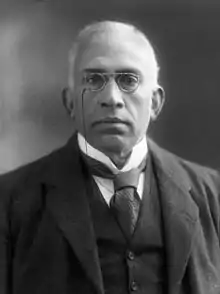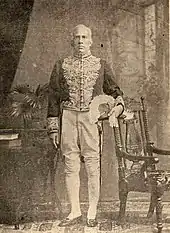C. Sankaran Nair
Sir Chettur Sankaran Nair, CIE (11 July 1857 – 24 April 1934) was a lawyer who also served as a President of the Indian National Congress in 1897 at the meeting held at Amravati. He wrote Gandhi and Anarchy (1922).
Sir Chettur Sankaran Nair | |
|---|---|
 | |
| Advocate General of the Madras Presidency | |
| In office 1906–1908 | |
| Preceded by | C. A. White |
| Succeeded by | P. S. Sivaswami Iyer |
| President of Indian National Congress | |
| In office 1897–1897 | |
| Preceded by | Rahimtulla M. Sayani |
| Succeeded by | Anandamohan Bose |
| Personal details | |
| Born | 11 July 1857 Chettur, Palakkad, Madras Presidency, India |
| Died | 24 April 1934 (aged 76) Madras, British India |
| Political party | Indian National Congress |
| Profession | Lawyer, jurist, activist, politician |
Early life and education
Chettur Sankaran Nair was born on 11 July 1857 in a Hindu Nair aristocratic family named Chettur, as the son of Mammayil Ramunni Panicker and Parvathy Amma Chettur in Mankara, Palakkad district. His father worked as a Tahsildar under the British government. His early education began in the traditional style at home and continued in schools in Malabar, till he passed the arts examination with a first class from the Provincial School at Calicut. Then he joined the Presidency College, Madras. In 1877 he took his arts degree, and two years later secured the law degree from the Madras Law College.
Career
Nair started as a lawyer in 1880 in the High Court of Madras. In 1884, the Madras Government appointed him as a member of the committee for an enquiry into the district of Malabar. Till 1908, he was the Advocate-General to the Government and an Acting Judge from time to time. In 1908, he became a permanent Judge in the High Court of Madras and held the post till 1915. He was a part of the bench that tried Collector Ashe murder case along with C. A. White, then the Chief Justice of Madras, William Ayling, as a special case.[1]
In the meantime, in 1902, the Viceroy Lord Curzon appointed him Secretary to the Raleigh University Commission. In recognition of his services, he was appointed a Companion of the Indian Empire by the King-Emperor in 1904[2] and in 1912 he was knighted.[3] He became a member of the Viceroy's Council in 1915 with the charge of the Education portfolio. As member, he wrote in 1919 two famous Minutes of Dissent in the Despatches on Indian Constitutional Reforms, pointing out the various defects of British rule in India and suggesting reforms. For an Indian to offer such criticism and make such demands was incredible in those days. The British government accepted most of his recommendations. Nair resigned from the Viceroy's Council in the aftermath of Jalianwalabagh massacre on 13 April 1919.
He played an active part in the Indian National movement which was gathering force in those days. In 1897, when the First Provincial Conference met in Madras, he was invited to preside over it. The same year, when the Indian National Congress assembled at Amaravathi, he was chosen its president. In a masterly address, he referred to the highhandedness of foreign administration, called for reforms and asked for self-government for India with Dominion Status. In 1900, he was a member of the Madras Legislative Council. His official life from 1908 to 1921 interrupted his activities as a free political worker. In 1928, he was the President of the Indian Central Committee to co-operate with the Simon Commission.[4] The Committee prepared a well-argued report asking for Dominion Status for India. When the Viceregal announcement came granting Dominion Status as the ultimate goal for India, Sir Sankaran Nair retired from active politics. He died in 1934, aged 77.
Family

Nair was married to his maternal cousin (uncle's daughter) Palat Kunhimalu Amma (later Lady Sankaran Nair) at a young age, according to the traditions of the time. She predeceased him in 1926, during a pilgrimage to the holy temple of Badrinath in present-day Uttarakhand. Their eldest daughter Lady Madhavan Nair and son-in-law and nephew Sir C. Madhavan Nair (a legal luminary and a judge of the Privy Council) lived on a large estate known as Lynwood, in Chennai. Within this property, in the area now known as Lady Madhavan Nair colony/Mahalinagapuram, is situated near the Ayappan-Guruvayoorappan temple, the land for which was donated by Lady Madhavan Nair. There are still many roads bearing names of the house – Lynwood avenue – and of the children of Sir and Lady Nair – Palat Narayani Amma road, Palat Sankaran Nair road, Palat Madhavan Nair road.
Nair also had five more children, among which another daughter - Saraswathy Amma a.k.a. Anuji - was married to the eminent diplomat K. P. S. Menon. Their son, Nair's grandson, also called K.P.S. Menon, and great-grandson Shivshankar Menon were also diplomats who served as Foreign Secretary. Shivshankar Menon also served as India's 4th National Security Advisor.
Nair's son R. M. Palat was also a noted politician in his own right.
Lieutenant General KP Candeth, the Western Army Commander during the Indo-Pak War of 1971 and the liberator of Goa, was another of Sir Sankaran Nair's grandsons.[5]
His nephew, V. M. M. Nair, was the oldest surviving ICS Officer in India when he died in 2021.[6]
Sankaran Nair's grand-nephew (niece Ammukutty Amma's son) was K. K. Chettur, an ICS officer who also served as India's first ambassador to Japan. He was the father of Jaya Jaitly, a politician and socialist, whose husband Ashok Jaitly was chief secretary of Jammu and Kashmir. Jaya's daughter Aditi is married to the former cricketer Ajay Jadeja.
Another grand-nephew of Sankaran Nair's was P.P. Narayanan (son of Chettur Narayanan Nair), a distinguished world trade unionist and leader in Malaysia (Morais 1984, introductory pages).[7]
References
- We care for Madras that is Chennai. Madras Musings (17 June 1911). Retrieved on 2012-06-11.
- London Gazette, 21 June 1904
- London Gazette, 12 July 1912
- Gautam Sharma (1 January 1996). Nationalisation of the Indian Army, 1885–1947. Allied Publishers. p. 113. ISBN 978-81-7023-555-2. Retrieved 11 June 2012.
- Autobiography of Sir C. Sankaran Nair. Lady Madhavan Nair. 1966.
- "V M M Nair, India's oldest ICS officer's 100th birthday on Oct 8 || Whispersinthecorridors". www.whispersinthecorridors.com. Retrieved 6 December 2019.
- Morais, John Victor 1910- (1985). P.P. Narayanan a world trade unionist : a biography. Unik Printguide.
Bibliography
- Gandhi and Anarchy (1922). Archive.org. Retrieved on 2012-06-11.